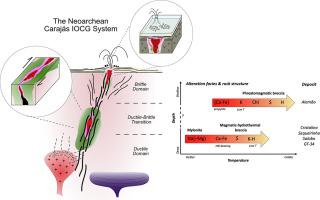当前位置:
X-MOL 学术
›
Ore Geol. Rev.
›
论文详情
Our official English website, www.x-mol.net, welcomes your
feedback! (Note: you will need to create a separate account there.)
From the roots to the roof: an integrated model for the Neoarchean Carajás IOCG System, Brazil
Ore Geology Reviews ( IF 3.2 ) Pub Date : 2020-12-01 , DOI: 10.1016/j.oregeorev.2020.103833 Maria Emilia Schutesky , Claudinei Gouveia de Oliveira
Ore Geology Reviews ( IF 3.2 ) Pub Date : 2020-12-01 , DOI: 10.1016/j.oregeorev.2020.103833 Maria Emilia Schutesky , Claudinei Gouveia de Oliveira

|
Abstract The Carajas Mineral Province, located in northern Brazil, comprises the oldest iron-oxide copper-gold mineralizing system on Earth and is one of the world’s most significant cluster of large-tonnage IOCG deposits. Based on a critical assessment of the literature a new integrated model for the Carajas Neoarchean IOCG deposits. The model considers the hydrothermal alteration footprint and the rock textures, the geometry of the mineralization and the ore assemblage, and the isotopic and geochronological signature. The majority of the deposits form in the hypozonal domain. Pervasive and well-developed sodic (-magnesian) and calcic-iron hydrothermal alteration halos form through magmatic-derived hydrothermal fluids. The occurrence of hydrothermal orthopyroxene(-marialite) in the Ni-rich GT-34 and Salobo deposits extend further the P-T boundaries to temperatures of up to 700°C and > 5 kbars, thus co is proposedrresponding to the root zone of the system. Epizonal deposits, conversely, are characterized by low-temperature potassic (biotite/phlogopite), propylitic and chloritic-hydrolytic hydrothermal assemblages, towards shallower crustal levels. Although a mantle contribution to the hydrothermal fluids is recognized, the O-B stable isotopic signature reveals the participation of surface-derived, basinal brines, in the ore-forming process. The occurrence of polymetallic ooids in the Alemao orebody (Igarape-Bahia deposit), hosting identical hydrothermal alteration mineralogy to the chalcopyrite breccias of other IOCG deposits in the Carajas Mineral Province suggests that the mineralizing fluids may have reached the paleo-surface of the Carajas basin in the Neoarchean, representing the roof of the IOCG system. Conversely, the ore mineralogy is consistent throughout the vertical scheme. Magnetite is the only iron oxide formed and precipitate from iron-rich hydrothermal alteration accompanying the calcic alteration. Similarly, chalcopyrite represents the Cu sulfide. There is no transition to more oxidized assemblages towards shallower zones, supporting that the overall system was relatively reduced since more oxidizing phases (hematite, bornite) are not observed as part of the Neoarchean IOCG system. Thus, the Neoarchean Carajas IOCG System represents a crustal-scale continuum, of a vertical paleo-hydrothermal system formed coevally to the voluminous, bimodal magmatism and the formation of the world-class, banded iron formation hosted iron ore.
中文翻译:

从根部到屋顶:巴西新太古代 Carajás IOCG 系统的集成模型
摘要 Carajas 矿产省位于巴西北部,包括地球上最古老的氧化铁铜金矿化系统,是世界上最重要的大吨位 IOCG 矿床群之一。基于对文献的批判性评估,Carajas Neoarchean IOCG 矿床的新综合模型。该模型考虑了热液蚀变足迹和岩石质地、矿化和矿石组合的几何形状,以及同位素和地质年代学特征。大多数沉积物形成于次区域。通过岩浆衍生的热液流体形成普遍且发育良好的钠(-镁)和钙铁热液蚀变晕。富镍 GT-34 和 Salobo 矿床中热液斜方辉石(-marialite)的出现将 PT 边界进一步扩展到温度高达 700°C 和 > 5 kbars,因此建议对应于系统的根区。相反,表带沉积物的特征是低温钾质(黑云母/金云母)、青橄榄岩和绿泥石-水解热液组合,朝向较浅的地壳水平。虽然地幔对热液流体的贡献已被确认,但 OB 稳定同位素特征揭示了地表衍生的盆地卤水在成矿过程中的参与。Alemao矿体(Igarape-Bahia矿床)多金属鲕类的赋存,拥有与 Carajas 矿产省其他 IOCG 矿床的黄铜矿角砾岩相同的热液蚀变矿物学表明,矿化流体可能已经到达了新太古代的 Carajas 盆地的古表面,代表了 IOCG 系统的顶部。相反,矿石矿物学在整个垂直方案中是一致的。磁铁矿是唯一由富含铁的热液蚀变伴随钙蚀变形成和沉淀的氧化铁。类似地,黄铜矿代表硫化铜。没有向更浅区域过渡到更多氧化组合,支持整个系统相对减少,因为没有观察到更多氧化相(赤铁矿、斑铜矿)作为新太古代 IOCG 系统的一部分。因此,
更新日期:2020-12-01
中文翻译:

从根部到屋顶:巴西新太古代 Carajás IOCG 系统的集成模型
摘要 Carajas 矿产省位于巴西北部,包括地球上最古老的氧化铁铜金矿化系统,是世界上最重要的大吨位 IOCG 矿床群之一。基于对文献的批判性评估,Carajas Neoarchean IOCG 矿床的新综合模型。该模型考虑了热液蚀变足迹和岩石质地、矿化和矿石组合的几何形状,以及同位素和地质年代学特征。大多数沉积物形成于次区域。通过岩浆衍生的热液流体形成普遍且发育良好的钠(-镁)和钙铁热液蚀变晕。富镍 GT-34 和 Salobo 矿床中热液斜方辉石(-marialite)的出现将 PT 边界进一步扩展到温度高达 700°C 和 > 5 kbars,因此建议对应于系统的根区。相反,表带沉积物的特征是低温钾质(黑云母/金云母)、青橄榄岩和绿泥石-水解热液组合,朝向较浅的地壳水平。虽然地幔对热液流体的贡献已被确认,但 OB 稳定同位素特征揭示了地表衍生的盆地卤水在成矿过程中的参与。Alemao矿体(Igarape-Bahia矿床)多金属鲕类的赋存,拥有与 Carajas 矿产省其他 IOCG 矿床的黄铜矿角砾岩相同的热液蚀变矿物学表明,矿化流体可能已经到达了新太古代的 Carajas 盆地的古表面,代表了 IOCG 系统的顶部。相反,矿石矿物学在整个垂直方案中是一致的。磁铁矿是唯一由富含铁的热液蚀变伴随钙蚀变形成和沉淀的氧化铁。类似地,黄铜矿代表硫化铜。没有向更浅区域过渡到更多氧化组合,支持整个系统相对减少,因为没有观察到更多氧化相(赤铁矿、斑铜矿)作为新太古代 IOCG 系统的一部分。因此,











































 京公网安备 11010802027423号
京公网安备 11010802027423号